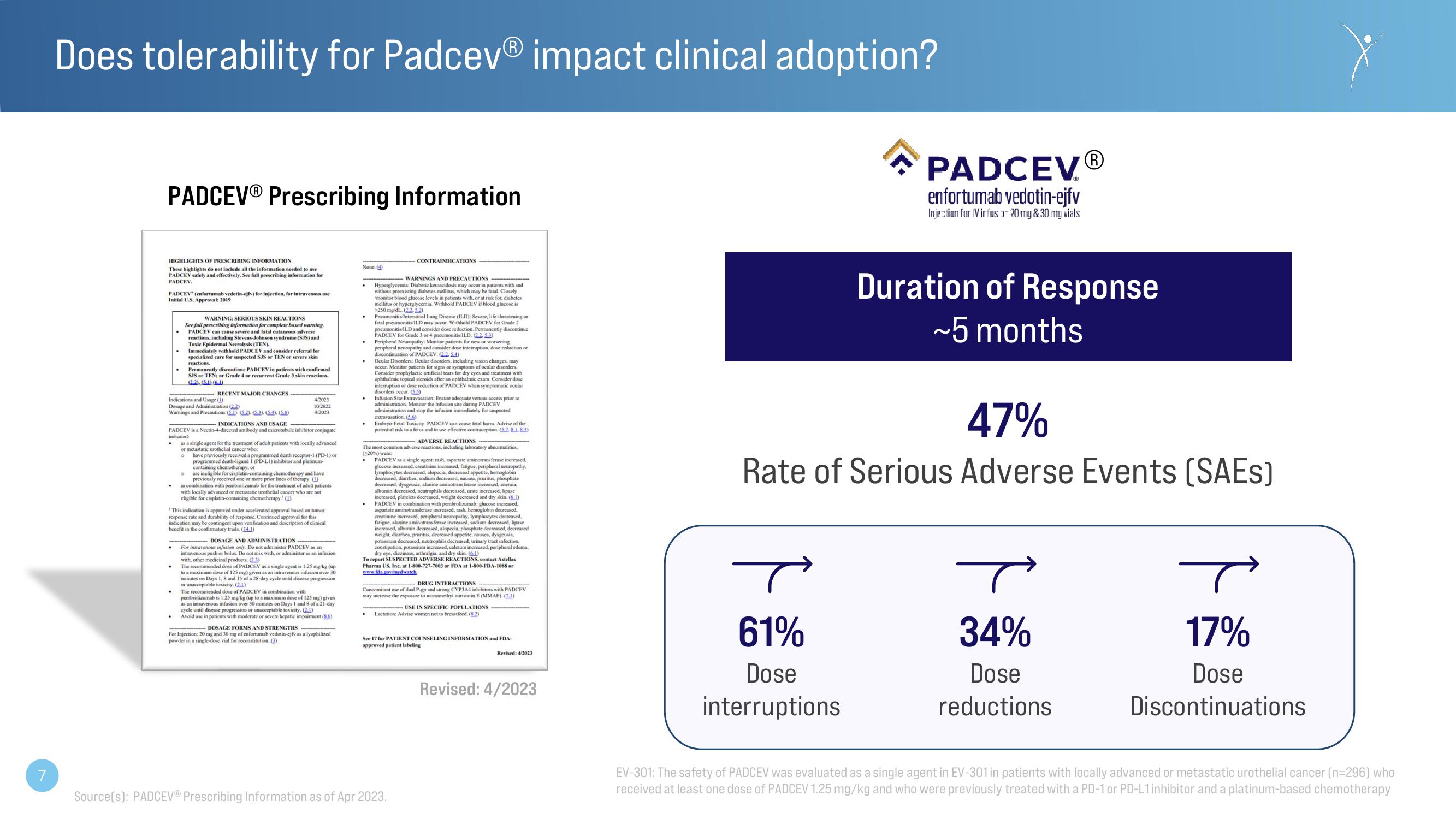Connecting Innovation to Purpose
Does tolerability for Padcev® impact clinical adoption?
PADCEVⓇ Prescribing Information
HIGHLIGHTS OF PRESCRIBING INFORMATION
These highlights do not include all the information needed to use
PADCEV safely and effectively. See full prescribing information for
PADCEV.
PADCEV (enfortumab vedotin-ejfv) for injection, for intravenous use
Initial U.S. Approval: 2019
WARNING: SERIOUS SKIN REACTIONS
See full prescribing information for complete boxed warning.
PADCEV can cause severe and fatal cutaneous adverse
reactions, including Stevens-Johnson syndrome (SIS) and
Toxic Epidermal Necrolysis (TEN).
Immediately withhold PADCEV and consider referral for
specialized care for suspected SJS or TEN or severe skin
reactions.
Permanently discontinue PADCEV in patients with confirmed
SJS or TEN; or Grade 4 or recurrent Grade 3 skin reactions.
(2.2), (5.1) (6.1)
.
RECENT MAJOR CHANGES
Indications and Usage (1)
Dosage and Administration (22)
Warnings and Precautions (5.1). (5.2). (5.3). (5.4). (5.6)
4/2023
10/2022
4/2023
INDICATIONS AND USAGE
PADCEV is a Nectin-4-directed antibody and microtubule inhibitor conjugate
indicated:
as a single agent for the treatment of adult patients with locally advanced
or metastatic urothelial cancer who:
0
have previously received a programmed death receptor-1 (PD-1) or
programmed death-ligand I (PD-L1) inhibitor and platinum-
containing chemotherapy, or
O are ineligible for cisplatin-containing chemotherapy and have
previously received one or more prior lines of therapy. (1)
in combination with pembrolizumab for the treatment of adult patients
with locally advanced or metastatic urothelial cancer who are not
eligible for cisplatin-containing chemotherapy. (1)
This indication is approved under accelerated approval based on tumor
response rate and durability of response. Continued approval for this
indication may be contingent upon verification and description of clinical
benefit in the confirmatory trials. (14.1)
DOSAGE AND ADMINISTRATION
For intravenous infusion only. Do not administer PADCEV as an
intravenous push or bolus. Do not mix with, or administer as an infusion
with, other medicinal products. (23)
The recommended dose of PADCEV as a single agent is 1.25 mg/kg (up
to a maximum dose of 125 mg) given as an intravenous infusion over 30
minutes on Days 1, 8 and 15 of a 28-day cycle until disease progression
or unacceptable toxicity. (21)
The recommended dose of PADCEV in combination with
pembrolizumab is 1.25 mg kg (up to a maximum dose of 125 mg) given
as an intravenous infusion over 30 minutes on Days 1 and 8 of a 21-day
cycle until disease progression or unacceptable toxicity. (2.1)
Avoid use in patients with moderate or severe hepatic impairment (8.6)
DOSAGE FORMS AND STRENGTHS
For Injection: 20 mg and 30 mg of enfortumab vedotin-ejfv as a lyophilized
powder in a single-dose vial for reconstitution. (3)
None. (4)
WARNINGS AND PRECAUTIONS
. Hyperglycemia: Diabetic ketoacidosis may occur in patients with and
without preexisting diabetes mellitus, which may be fatal. Closely
/monitor blood glucose levels in patients with, or at risk for, diabetes.
mellitus or hyperglycemia. Withhold PADCEV if blood glucose i
e is
>250 mg/dl. (22.5.2)
.
CONTRAINDICATIONS
.
Pneumonitis/Interstitial Lung Disease (ILD): Severe, life-threatening or
fatal pneumonitis ILD may occur. Withhold PADCEV for Grade 2
pneumonitis/ILD and consider dose reduction Permanently discontinue
PADCEV for Grade 3 or 4 pneumonitis/ILD. (2.2, 5.3)
Peripheral Neuropathy: Monitor patients for new or worsening
peripheral neuropathy and consider dose interruption, dose reduction of
discontinuation of PADCEV. (2.2. 5.4)
Infusion Site Extravasation: Ensure adequate venous access prior to
administration. Monitor the infusion site during PADCEV
administration and stop the infusion immediately for suspected
extravasation. (5.6)
. Embryo-Fetal Toxicity: PADCEV can cause fetal harm. Advise of the
potential risk to a fetus and to use effective contraception. (5.7. 8.1, 8.3)
ADVERSE REACTIONS
The most common adverse reactions, including laboratory abnormalities,
(220%) were:
PADCEV as a single agent: rash, aspartate aminotransferase increased.
glucose increased, creatinine increased, fatigue, peripheral neuropathy,
lymphocytes decreased, alopecia, decreased appetite, hemoglobin
decreased, diarrhea, sodium decreased, nausea, pruritus, phosphate
decreased, dysgeusia, alanine aminotransferase increased, anemia,
albumin decreased, neutrophils decreased, urate increased, lipase
increased, platelets decreased, weight decreased and dry skin. (6.1)
PADCEV in combination with pembrolizumab: glucose increased,
aspartate aminotransferase increased, rash, hemoglobin decreased,
creatinine increased, peripheral neuropathy, lymphocytes decreased,
fatigue, alanine aminotransferase increased, sodium decreased, lipase
increased, albumin decreased, alopecia, phosphate decreased, decreased
weight, diarrhea, pruritus, decreased appetite, nausea, dysgeusia.
potassium decreased, neutrophils decreased, urinary tract infection,
constipation, potassium increased, calcium increased, peripheral edema,
dry eye, dizziness, arthralgia, and dry skin. (6.1)
To report SUSPECTED ADVERSE REACTIONS, contact Astellas
Pharma US, Inc. at 1-800-727-7003 or FDA at 1-800-FDA-1088 or
www.fda.gov/medwatch
Ocular Disorders: Ocular disorders, including vision changes, may
occur. Monitor patients for signs or symptoms of ocular disorders.
Consider prophylactic artificial tears for dry eyes and treatment with
ophthalmic topical steroids after an ophthalmic exam. Consider dose
interruption or dose reduction of PADCEV when symptomatic ocular
disorders occur. (5.5)
DRUG INTERACTIONS
Concomitant use of dual P-gp and strong CYP3A4 inhibitors with PADCEV
may increase the exposure to monomethyl auristatin E (MMAE) (7.1)
-USE IN SPECIFIC POPULATIONS
. Lactation: Advise women not to breastfeed. (8.2)
See 17 for PATIENT COUNSELING INFORMATION and FDA-
approved patient labeling
Source(s): PADCEVⓇ Prescribing Information as of Apr 2023.
Revised: 4/2023
Revised: 4/2023
1
T
61%
Dose
interruptions
PADCEVⓇ
enfortumab vedotin-ejfv
Injection for IV infusion 20 mg & 30 mg vials
Duration of Response
~5 months
47%
Rate of Serious Adverse Events (SAES)
T
34%
Dose
reductions
T
17%
Dose
Discontinuations
EV-301: The safety of PADCEV was evaluated as a single agent in EV-301 in patients with locally advanced or metastatic urothelial cancer (n=296] who
received at least one dose of PADCEV 1.25 mg/kg and who were previously treated with a PD-1 or PD-L1 inhibitor and a platinum-based chemotherapyView entire presentation